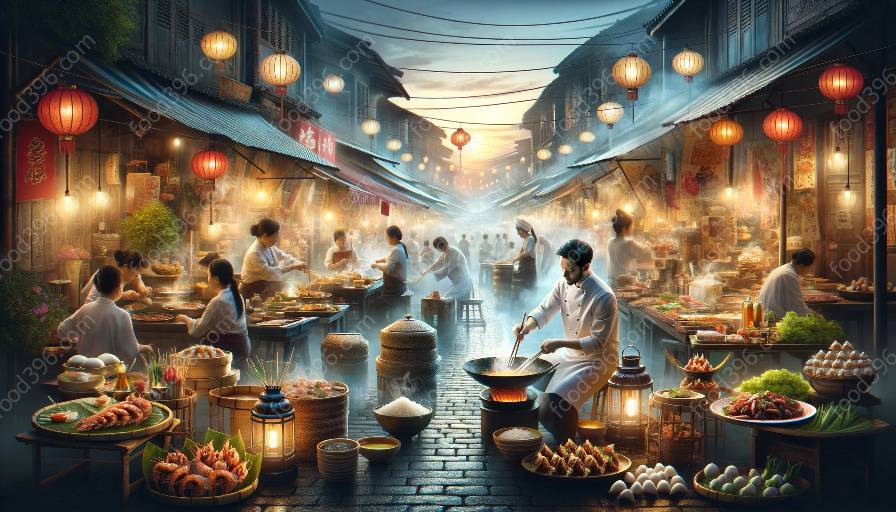Japanese cuisine boasts a rich history that reflects the country's diverse cultural influences and culinary traditions. The evolution of Japanese cuisine is shaped by its unique cultural, geographical, and historical background, making it a treasure trove of flavors, techniques, and traditions.
From the ancient origins of Japanese cooking to the modern world of sushi, sashimi, and noodles, Japanese cuisine has captivated food enthusiasts worldwide. The history of Japanese cuisine is intricately linked to the broader context of Asian cuisine history and global culinary influences.
Origins of Japanese Cuisine
The roots of Japanese cuisine can be traced back to ancient times when the indigenous people of Japan, the Jomon, developed early forms of cooking and food preservation techniques. Their diet mainly consisted of seafood, wild game, vegetables, and fruits gathered from the land.
As Japan's cultural and culinary landscape evolved, influences from neighboring Asian countries, notably China and Korea, began to shape the traditional Japanese diet. The introduction of rice cultivation, soybeans, and various cooking methods greatly impacted the development of Japanese cuisine, laying the foundation for its distinctive flavors and cooking styles.
Asian Cuisine History and Japanese Culinary Traditions
Japanese cuisine is an integral part of the broader tapestry of Asian cuisine history. The exchange of culinary techniques, ingredients, and flavors across Asia has contributed to the diversity and complexity of Japanese cooking. The influence of Chinese cooking, in particular, has deeply influenced Japanese culinary traditions, leading to the creation of iconic dishes such as ramen, gyoza, and various styles of stir-fries.
Japanese cuisine also shares common elements with other Asian cuisines, such as the use of aromatic spices, fermented foods, and umami-rich ingredients. The interconnectedness of Asian culinary histories highlights the cross-cultural exchanges that continue to shape the vibrant tapestry of flavors and culinary techniques found in Japanese cuisine.
The Evolution of Traditional Japanese Dishes
Over the centuries, Japanese cuisine has undergone dynamic transformations, adapting to changes in social, political, and agricultural landscapes. The refinement of traditional Japanese dishes, including sushi, tempura, and kaiseki, reflects a meticulous attention to detail, balance, and seasonal ingredients.
Additionally, the development of washoku, the traditional dietary culture of the Japanese, has been recognized as an Intangible Cultural Heritage by UNESCO. Washoku embodies the harmony of tastes, colors, and cooking techniques, emphasizing the intrinsic connection between nature and food in Japanese culinary traditions.
Global Influences on Japanese Cuisine
As Japan opened its doors to the world, the influence of global cuisines began to leave an indelible mark on Japanese cooking. The introduction of Western ingredients, cooking methods, and culinary concepts led to the creation of fusion dishes and innovative culinary fusions.
From the adoption of foreign ingredients like potatoes and tomatoes to the incorporation of Western culinary techniques, Japanese cuisine experienced a culinary revolution that expanded its repertoire while preserving its cultural authenticity. This convergence of global influences highlighted the adaptability and creativity of Japanese chefs, leading to the emergence of new culinary movements and gastronomic experiences.
The Art of Japanese Culinary Techniques
Japanese culinary mastery goes beyond the creation of delectable dishes; it embodies the art of meticulous preparation, knife skills, and a deep respect for ingredients. The meticulous process of slicing sashimi, the precision of sushi-making, and the discipline of teppanyaki exemplify the highest standards of craftsmanship and culinary expertise.
Moreover, the concept of umami, the fifth basic taste, is deeply ingrained in Japanese culinary traditions, contributing to the complexity and depth of flavors in Japanese cuisine. The art of fermentation, pickling, and preserving ingredients has also been integral to preserving the essence of Japanese culinary heritage.
Modern Trends in Japanese Cuisine
Contemporary Japanese cuisine continues to evolve, embracing new trends, culinary innovations, and global influences. The fusion of traditional techniques with modern creative expressions has given rise to a new wave of Japanese gastronomy, characterized by experimentation, sustainability, and culinary artistry.
Furthermore, the global appreciation for Japanese cuisine has led to the proliferation of Japanese restaurants worldwide, enhancing the visibility and appreciation of Japanese culinary traditions. With advancements in technology and a growing emphasis on sustainability, Japanese chefs are redefining the boundaries of culinary excellence while preserving the essence of time-honored traditions.
Exploring the Depth of Japanese Cuisine
The journey through the history of Japanese cuisine unveils a captivating narrative of cultural exchange, culinary ingenuity, and timeless traditions. Whether savoring a delicate bowl of ramen or savoring the artistry of a traditional tea ceremony, Japanese cuisine offers a multi-sensory exploration of flavors, aesthetics, and cultural heritage.
As the world embraces the allure of Japanese gastronomy, the legacy of Japanese cuisine continues to inspire a global culinary renaissance, enriching the tapestry of global cuisine with its unmatched depth and diversity.

